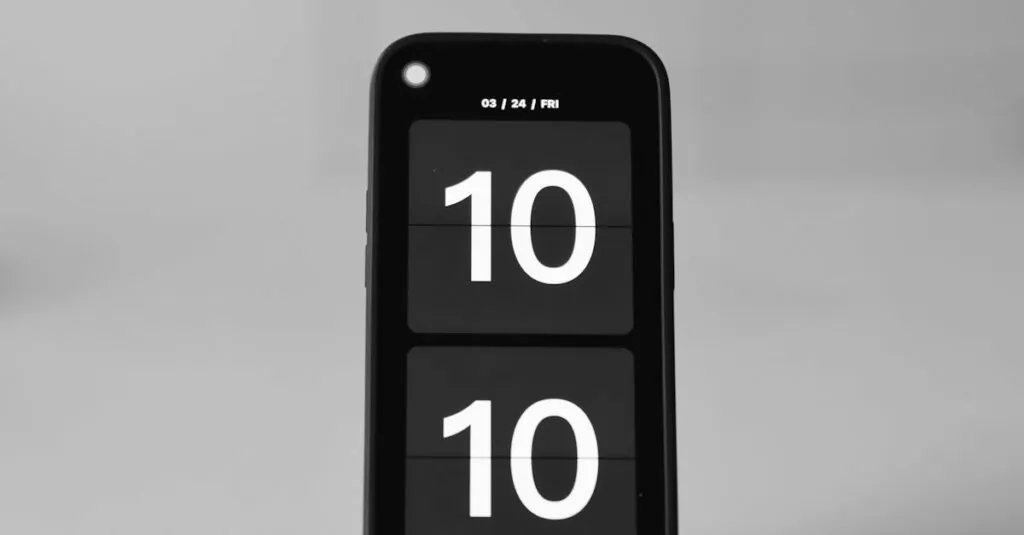Table of Contents
ToggleCapturing moments on an iPhone SE (1st generation) shouldn’t feel like solving a Rubik’s Cube blindfolded. Whether it’s a hilarious meme or a must-have recipe, knowing how to take a screenshot can save the day—and your sanity.
In a world where sharing is caring, screenshots are the digital equivalent of a high-five. They let you snag that perfect moment and share it with friends or just keep it for yourself. Plus, it’s way easier than trying to explain a funny TikTok to someone who hasn’t seen it.
Overview of iPhone SE (1st Generation)
The iPhone SE (1st generation) debuted in March 2016, combining the powerful performance of the iPhone 6S with a compact design. It features a 4-inch Retina display, offering sharp visuals and vibrant colors. Equipped with the A9 chip, this phone delivers impressive speed and efficiency for various tasks.
Users appreciate the 12-megapixel rear camera, which captures high-quality photos and supports 4K video recording. With Live Photos and advanced camera features, it enhances photography experiences. The device also maintains an 8-megapixel front camera for selfies and video calls.
It includes Touch ID for added security, allowing users to unlock their phones and make purchases effortlessly. With storage options of 16GB, 32GB, 64GB, or 128GB, the device accommodates diverse user needs. The iPhone SE runs on iOS, providing access to a wide range of applications and services.
Battery life remains strong, featuring up to 14 hours of talk time. The lightweight design and compact size make it comfortable to hold and use single-handedly. Users enjoy various color options, including Space Gray, Silver, and Gold, making it easy to find a personal style.
The iPhone SE (1st generation) offers a blend of modern performance and classic design. It caters to users seeking a smaller device without compromising on functionality, making it an appealing choice in the smartphone market.
Methods to Take a Screenshot
Capturing a screenshot on an iPhone SE (1st generation) can be done in two primary ways. Understanding both methods allows for flexibility based on user preference.
Using Button Combinations
Pressing the Home button and the Sleep/Wake button simultaneously takes a screenshot. Holding both buttons for a brief moment captures the screen’s content. After a successful screenshot, a thumbnail appears in the lower-left corner. Tapping this thumbnail allows for immediate editing or sharing options. This method provides a quick and straightforward way to capture images from apps, messages, or web pages.
Using AssistiveTouch
Enabling AssistiveTouch offers an alternative for taking screenshots without button presses. Users can turn on AssistiveTouch through Settings, then navigate to Accessibility. Once enabled, tapping the floating button presents an options menu. Selecting “Device” followed by “More” reveals the “Screenshot” option. This method suits those who prefer a touch interface, especially when physical buttons are inconvenient. The convenience of AssistiveTouch ensures anyone can capture vital information effortlessly.
Tips for Taking Effective Screenshots
Taking effective screenshots enhances sharing and communication on the iPhone SE (1st generation). Users can follow these tips to capture the best moments.
Optimal Timing for Screenshots
Timing matters when capturing screenshots. Users should aim to take a screenshot immediately while the content appears on the screen. If capturing a video or a live moment, press the buttons when the desired frame is visible. Rapidly pressing the buttons minimizes the chance of missing important information. Observing how the content loads can help determine the right moment.
Editing and Annotating Screenshots
Editing screenshots improves clarity and focus. After capturing a screenshot, tap the thumbnail to access editing tools. Users can crop, rotate, and annotate images with text or drawings. Utilizing various colors and thickness can emphasize specific areas or information. Saving the edited screenshot is essential for sharing later. These simple adjustments can transform a basic screenshot into a useful communication tool.
Common Issues and Troubleshooting
Taking screenshots on the iPhone SE (1st generation) can sometimes present challenges. Users may find that screenshots do not save to the Photos app. This issue often occurs due to insufficient storage space. Checking available storage is a quick solution.
Another common problem involves the screenshot not capturing the intended content. Capturing the screen requires precise timing with the buttons. Users can double-check their button pressing technique to ensure the screenshot activates correctly.
If the thumbnail for editing or sharing doesn’t appear after taking a screenshot, this might be a minor software glitch. Restarting the device can resolve temporary software issues. In some cases, updating the iOS version might fix any underlying problems related to the screenshot feature.
AssistiveTouch offers a more accessible option for taking screenshots. However, users may encounter difficulties if the feature is not enabled. To activate AssistiveTouch, navigate to Settings and then to Accessibility. This feature can help if physical buttons are problematic.
Occasionally, users report that images appear blurry or unclear. Ensuring the content to be captured is fully loaded can help improve clarity. Trying to avoid motion on the screen during capture also promotes a clearer screenshot.
For those still facing issues, resetting all settings can be another approach. This action restores configurations without deleting personal data. The last resort is contacting Apple Support for professional assistance. They can provide tailored solutions to specific problems related to screenshot functionality.
Taking screenshots on the iPhone SE (1st generation) is a straightforward process that enhances communication and convenience. Whether capturing a memorable moment or sharing important information, users can easily utilize the physical buttons or AssistiveTouch for seamless screenshot functionality.
By following best practices for timing and editing, individuals can transform their screenshots into powerful tools for sharing and collaboration. Addressing common issues ensures that users can continue to enjoy this feature without frustration. With its compact design and robust capabilities, the iPhone SE remains a reliable choice for those who value both performance and ease of use in their daily digital interactions.





